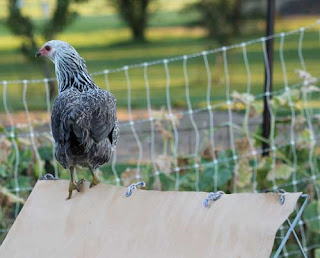The cabbages were rotting. I wasn’t sure why, but our three recent torrential rains were leading suspects. Even though we irrigate, a sudden burst of water will often cause cabbages (and tomatoes) to split. Once the head is split, fungus can move in, especially if another rain washes the spores in between the leaves. This year was different though. A few heads split, but did not rot, while some unsplit heads suddenly went all black. It was a mystery. What was certain was that the sauerkraut had to be made immediately.
As I was pulling off the outer leaves of a Stonehead cabbage, I realized that hail was probably at least some of the problem. The cabbage had several small splits in it. Underneath the splits were moldy spots.
 |
| Two small breaks, upper left, underlying rot on the right |
Luckily, the inside of the cabbage was perfect. The last Savoy cabbage I harvested had bad leaf in the middle of all the others. That is so annoying.
 |
| No rot inside. Victory! |
Making sauerkraut isn’t like it used to be. At first, Pat
and Nancy came to help Hilda and me. Last year, Jane replaced Pat. This year, Hilda
was gone too, and Nancy was out of town. So it was just Jane and me.
Here I am shredding the cabbage, wearing my wire mesh glove so I don’t cut my fingers off in the mandolin.
 |
| Shredding cabbage on a sauerkraut cutter |
Jane weight the shreds and put them in a bowl. When we got to 2.5 pounds, we added 1/8 cup salt and packed the cabbage into a crock. A few hours later, I was pleased to see that the cabbage gave up enough moisture to cover itself. Fermentation is an anaerobic process. Let the air in, and you have a big, stinky mess that has to be thrown out.
 |
| Weights keeping cabbage submerged for fermentation |
We did four cabbages and
ended up with 16 ¼ pounds of sauerkraut. I’m sure that will be plenty, particularly
in light of the fact that we still haven’t finished what we put up in 2019. I’m
counting on Nancy taking her usual share.
With the first day of fall coming up this week, we had to move the chickens up to Coop 1, where we can artificially extend their day to 14 hours so they will keep laying. The flock is not yet integrated. The pullets and the hens perch on opposite ends of the perch for the night.
 |
| Segregated perching--pullets left, hens right |
The pullets miss the shade of the apple trees. Before the sun comes up over the tractor shed, they will walk around in the run.
 |
| Pullets wander the upper run |
Or stand on the wind break.
 |
| Americauna pullets on the windbreak. |
Miss USA likes to perch on top of the shade shelters.
 |
| Miss USA surveying the run from to the top of a shade shelter |
 |
| Hard to turn on such a narrow perch |
Most of the day, though, they hang out in the dog kennel, looking glum.
You may recall that two of the Australorps were, ahem, peckers who tormented the Wyandotts, pecking all the cover feathers off their backs, leaving only the down. I knew because only the Australorps had full plumage. With the Australorps gone, I expected the Wyandotts to grow their beautiful black-edged white feathers back. Not so much. One is getting more feathers.
 |
| Wyandott growing feathers on her back |
The other two are not. Who’s the mean girl now?
 |
| Still not many back feathers on this one |
When I went out at sunrise yesterday morning to do my chicken chores, I saw a bumblebee asleep on a goldenrod. I have read that bumblebees can heat themselves up better than other bees and therefore be active at lower temperatures, but the morning must have been too cool for this one.
 |
| Bumblebee sleeping on goldenrod |
Terry found this cicada in a Japanese beetle trap. I've been hearing them for weeks, but had not seen one.
 |
| Cicada |
As least we’ve got the sauerkraut done.


No comments:
Post a Comment